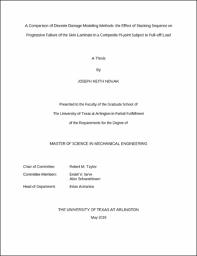
ATTENTION: The works hosted here are being migrated to a new repository that will consolidate resources, improve discoverability, and better show UTA's research impact on the global community. We will update authors as the migration progresses. Please see MavMatrix for more information.
Show simple item record
| dc.contributor.advisor | Taylor, Robert M. | |
| dc.contributor.advisor | Nomura, Seiichi | |
| dc.creator | Novak, Joseph Keith | |
| dc.date.accessioned | 2019-05-28T21:45:14Z | |
| dc.date.available | 2019-05-28T21:45:14Z | |
| dc.date.created | 2019-05 | |
| dc.date.issued | 2019-05-07 | |
| dc.date.submitted | May 2019 | |
| dc.identifier.uri | http://hdl.handle.net/10106/28128 | |
| dc.description.abstract | Discrete damage modeling of composite failure mechanisms including delamination, matrix cracking, and their interactions was performed for the skin laminate in a composite pi-joint test specimen subject to a pull-off load. The skin laminate stacking sequence was varied, and the pull-off load and path of predicted damage were recorded. Within the study two discrete damage modeling tools were used, Abaqus XFEM with a LaRC05 built-in user subroutine and BSAM. Both tools implement failure criteria developed at the NASA Langley Research Center (LaRC) to predict the location of damage initiation and both tools use similar cohesive zone models to model damage accumulation and crack propagation of matrix cracks and delaminations. However, the tools differ in their approach of modeling mesh independent matrix cracks in the bulk lamina. Abaqus XFEM implements a standard formulation of the eXtended Finite Element Method (XFEM), whereas BSAM uses a Regularized eXtended Finite Element Method (RxFEM). The results of the discrete damage modeling tools were compared with baseline models that only considered interface damage. It was shown that by including effects of matrix cracks the peak pull-off loads were considerably reduced. Moreover, the predicted failure path between the baseline and discrete damage models were vastly different. Comparing the discrete damage models, the prediction of the first damage site was in agreement, and the paths of predicted damage and peak pull-off loads were similar. The convergence of the BSAM solver was found to be superior as the Abaqus solver would diverge when damage occurred at multiple sites and the interaction became complex. | |
| dc.format.mimetype | application/pdf | |
| dc.language.iso | en_US | |
| dc.subject | Discrete damage modeling | |
| dc.subject | DDM | |
| dc.subject | XFEM | |
| dc.subject | Progressive failure | |
| dc.subject | Pi-joint | |
| dc.subject | Composite failure | |
| dc.subject | Delamination | |
| dc.subject | Matrix cracking | |
| dc.subject | BSAM | |
| dc.subject | RxFEM | |
| dc.subject | Cohesive zone model | |
| dc.subject | LaRC | |
| dc.title | A Comparison of Discrete Damage Modeling Methods: the Effect of Stacking Sequence on Progressive Failure of the Skin Laminate in a Composite Pi-joint Subject to Pull-off Load | |
| dc.type | Thesis | |
| dc.degree.department | Mechanical and Aerospace Engineering | |
| dc.degree.name | Master of Science in Mechanical Engineering | |
| dc.date.updated | 2019-05-28T21:45:46Z | |
| thesis.degree.department | Mechanical and Aerospace Engineering | |
| thesis.degree.grantor | The University of Texas at Arlington | |
| thesis.degree.level | Masters | |
| thesis.degree.name | Master of Science in Mechanical Engineering | |
| dc.type.material | text | |
| dc.creator.orcid | 0000-0001-5832-3935 | |
Files in this item
- Name:
- NOVAK-THESIS-2019.pdf
- Size:
- 3.963Mb
- Format:
- PDF
This item appears in the following Collection(s)
Show simple item record


